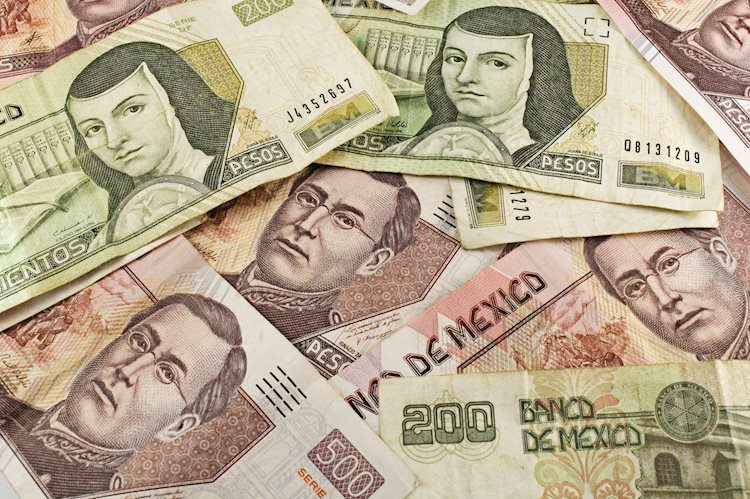- Mexican Peso collapses as USD/MXN climbs past 19.50 after bouncing from daily lows.
- IMF predicts Mexico’s economy will grow 1.5% in 2024, further deceleration to 1.3% in 2025.
- San Francisco Fed’s Mary Daly hints at possible rate cuts, boosting USD amid a mixed US economic outlook.
The Mexican Peso lost over 1% against the US Dollar during the North American session as the Greenback strengthened on risk aversion. A scarce economic docket in Mexico left traders leaning on US data, which was mixed as inflation expectations edged higher. The USD/MXN trades at 19.66 after bouncing off daily lows of 19.33.
Market sentiment is downbeat and weighed on risk-sensitive currencies like the Peso. In the meantime, the International Monetary Fund (IMF) revealed that Mexico’s economy is expected to grow by 1.5% in 2024, citing capacity constraints and tight monetary policy.
Next year, the economy is foreseen decelerating further to 1.3%, adding that inflation is expected to get closes to the Bank of Mexico’s (Banxico) 3% goal. The Institute said that “inflation risks remain on the upside” and warned that an economic slowdown in the US, geopolitics, and unforeseen impacts from the judicial reform could impact Mexico’s economy.
Across the border, the New York Empire State Manufacturing Index posted a dismal print, while the latest New York Fed Survey for Inflation Expectations in September remained unchanged at 3%.
The USD/MXN reacted to the upside on remarks by San Francisco Fed President Mary Daly, which sponsored a leg-up toward the current exchange rate. She said the Fed’s dual mandate risks are now in balance and that the labor market is not a source of inflation.
Daly added that she’s cautiously optimistic about the economic outlook and foresees one or two rate cuts “if forecasts are met.”
Ahead in the week, the US economic docket will feature the Balance of Trade on Wednesday. On Thursday, a busy schedule would be led by the release of Retail Sales, Initial Jobless Claims, Industrial Production and further Fed speakers.
Daily digest market movers: Mexican Peso weakens as USD/MXN surges
- Mexico’s deterioration in Consumer Confidence and the IMF forecast weighed on the Mexican Peso, which is falling to two-week lows as USD/MXN rises to 19.67.
- The IMF said that a recent judicial reform creates “important uncertainties about the effectiveness of contract enforcement and the predictability of the rule of law.”
- Banxico’s survey revealed that economists estimate the central bank will lower rates by 50 bps for the rest of the year. The USD/MXN exchange rate is projected to end at 19.69, and the economy is expected to grow by 1.45% in 2024.
- The New York Empire State Manufacturing Index for October, which was expected to drop from 11.3 to 2.3, came in at -11.90.
- Data from the Chicago Board of Trade via the December fed funds rate futures contract shows investors estimate 49 bps of Fed easing by the end of the year.
USD/MXN technical outlook: Mexican Peso plummets as USD/MXN eyes 19.70
The USD/MXN uptrend has extended for the second straight day, with buyers eyeing higher prices. Momentum favors buyers, as seen in the Relative Strength Index (RSI).
Given the backdrop, the USD/MXN’s next resistance would be the October 1 high at 19.82. Once surpassed, the next stop would be the 20.00 figure, followed by the YTD peak of 20.22.
Conversely, if USD/MXN tumbles below the October 10 daily high of 19.61, up next will be the October 4 swing low of 19.10 before testing 19.00. Once broken, the next support would be the 100-day SMA at 18.78.
GDP FAQs
A country’s Gross Domestic Product (GDP) measures the rate of growth of its economy over a given period of time, usually a quarter. The most reliable figures are those that compare GDP to the previous quarter e.g Q2 of 2023 vs Q1 of 2023, or to the same period in the previous year, e.g Q2 of 2023 vs Q2 of 2022. Annualized quarterly GDP figures extrapolate the growth rate of the quarter as if it were constant for the rest of the year. These can be misleading, however, if temporary shocks impact growth in one quarter but are unlikely to last all year – such as happened in the first quarter of 2020 at the outbreak of the covid pandemic, when growth plummeted.
A higher GDP result is generally positive for a nation’s currency as it reflects a growing economy, which is more likely to produce goods and services that can be exported, as well as attracting higher foreign investment. By the same token, when GDP falls it is usually negative for the currency. When an economy grows people tend to spend more, which leads to inflation. The country’s central bank then has to put up interest rates to combat the inflation with the side effect of attracting more capital inflows from global investors, thus helping the local currency appreciate.
When an economy grows and GDP is rising, people tend to spend more which leads to inflation. The country’s central bank then has to put up interest rates to combat the inflation. Higher interest rates are negative for Gold because they increase the opportunity-cost of holding Gold versus placing the money in a cash deposit account. Therefore, a higher GDP growth rate is usually a bearish factor for Gold price.
Read the full article here

